Few outdoor activities can match the thrill and serenity of kayaking. Whether you’re weaving through meandering rivers, paddling across vast lakes, or navigating imposing ocean waves, kayaking offers an unmatched opportunity to explore nature’s beauty and challenge yourself. Yet, as exhilarating as this sport is, it also demands preparation. Embarking on a kayaking expedition without the right gear can be not only frustrating but also potentially dangerous.
That’s why, whether you’re a seasoned paddler or new to the sport, it’s vital to pack the right equipment and supplies before launching your kayak. This article breaks down everything you’ll need in order to have a safe, enjoyable kayaking experience, from essential gear and clothing to emergency supplies, nourishment, and communication tools. So, let’s dive in and explore the items that should be on your kayaking checklist. That way, you can focus on the adventure ahead, with the confidence that you’re well-prepared for whatever your journey brings.
Contents
Contents
Essential Gear And Clothing To Bring When Kayaking in 2024
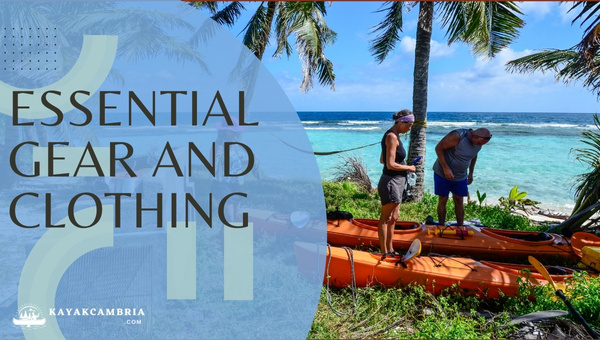
Preparing for a kayaking trip means having the right gear and clothing to ensure a comfortable and safe experience. Here’s a list of items to consider:
1. Personal Floatation Device (PFD)
Wearing a PFD is crucial for your safety while kayaking. Select a PFD specifically designed for paddling, which offers a secure fit, freedom of movement, and sufficient buoyancy.
2. Paddle
Choose a paddle suitable for your size and kayaking style. Options include materials, lengths, and blade shapes. It’s also a good idea to bring a backup paddle to avoid being stranded in case of damage or loss.
3. Helmet
If you plan on tackling rapid waters or rocky environments, a helmet is essential for protecting your head from potential impacts.
4. Weather-appropriate Clothing
Dress for the weather and water conditions. This may include wearing a wetsuit or dry suit in colder waters, or shorts and a breathable shirt in warmer temperatures. Remember to consider the risk of changing weather and adjust your clothing accordingly.
5. Dry Bags
Protect your belongings from water damage by using dry bags or waterproof cases. These come in various sizes to accommodate different items like clothing, food, and electronics.
6. Sun Protection
Even when the sun is hiding, its UV rays can still be harmful. Equip yourself with sun protection elements like a hat, sunglasses, and sunscreen to shield your skin and eyes from the sun’s damaging rays.
By ensuring you have these essential gear and clothing items, your kayaking experience will be both enjoyable and safe.
Proper Footwear And Layering Options To Bring When Kayaking
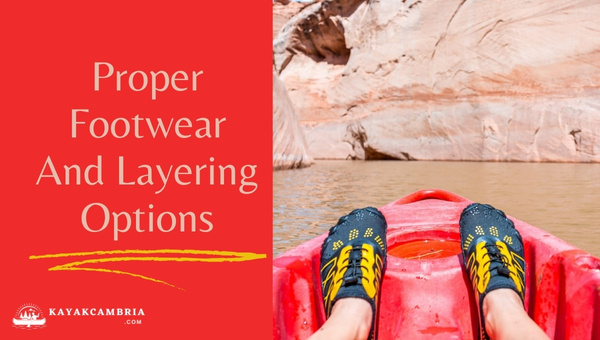
Choosing the right footwear for kayaking is essential to ensure your comfort and safety on the water. Water-resistant or water shoes are the ideal options as they provide excellent grip on wet surfaces and dry quickly.
1. Wetsuits, Dry Suits or Rash Guards
Depending on the water temperature, you may want to consider wearing a wetsuit, dry suit, or rash guard. These provide insulation and protect your skin from abrasion, sunburn, and cold water.
2. Light Layers For Changing Conditions
As the weather can change rapidly, it’s essential to have light layers with you to adapt to varying conditions. Opt for quick-drying fabrics like polyester blends, as they wick away moisture and keep you warm even when wet.
| Layer Type | Purpose |
| Base Layer | Wicks moisture away from skin, retains heat |
| Middle Layer | Provides insulation, warmth, and moisture management |
| Outer Layer | Protects from wind, rain, and abrasion |
Tips for Dressing in Layers
- Avoid cotton, as it takes a long time to dry and can cause problems with heat loss and overall comfort.
- Make sure your layers fit comfortably without restricting movement.
- Tailor your layering approach to the specific conditions you expect to face.
Safety Equipment And Emergency Supplies To Bring When Kayaking in 2024
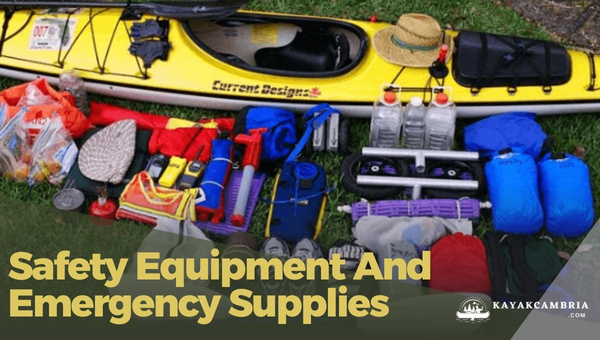
When I embark on a kayaking adventure, I am always mindful of safety. No matter how skilled we are, it is always possible to encounter situations that require immediate attention. To stay prepared, I make sure to pack a variety of safety equipment and emergency supplies. The following are some of the essential items that should be part of any kayaker’s kit:
1. First Aid Kit
A first aid kit is an essential item for any outdoor activity. I always carry one containing adhesive bandages, sterile dressings, adhesive tape, antiseptic wipes, medication, and tweezers, among other things. It’s better to be safe than sorry!
2. Whistle or Signal Device
A whistle or signal device can quite literally be a lifesaver if I need to attract attention. They are small, lightweight, and easily attachable to a PFD.
3. Towline or Throw Bag
A towline or throw bag is an important piece of equipment that can help with rescue efforts, securing the kayak, or just assisting a fellow paddler.
4. Bilge Pump
A bilge pump is essential to drain water from the kayak in case of a capsize or filling with water from waves or rain. It’s a handy tool to keep the kayak dry and stable.
5. Repair Kit
I always bring a repair kit with me, including items to fix potential damage to the kayak, paddle, or other equipment. This may contain duct tape, a multi-tool, and spare parts.
6. Multi-tool or Knife
A reliable multi-tool or knife can do wonders during emergencies. From cutting rope to opening a food container that just won’t budge, I find it essential to have one on hand.
I always carry navigation tools, like a map, compass, and GPS system, when exploring unfamiliar waters. These tools keep me on track and help me plan my route efficiently.
By ensuring that I have this safety equipment and emergency supplies on hand during my kayaking trips, I can tackle any situation confidently and safely. Remember, outdoor adventures are meant to be enjoyable, but being prepared for emergencies is critical to making the most out of them.
Food, Water, And Snacks To Bring When Kayaking in 2024
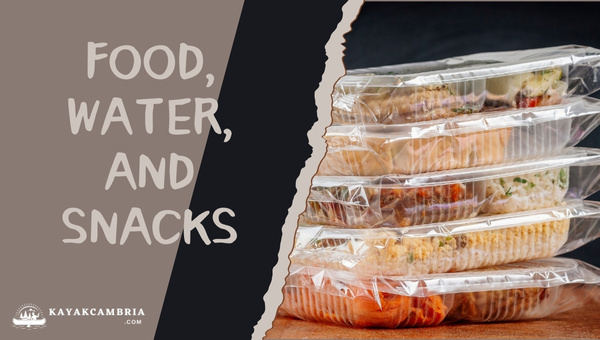
One of the most important aspects of a successful day kayaking is ensuring you have enough food, water, and snacks to keep your energy levels high.
1. Staying Hydrated
Hydration is an essential factor to consider when out on the water. Paddling can be strenuous work, and it’s vital to drink plenty of water to stay hydrated. Always pack more water than you think you will need, and invest in a high-quality water bottle or hydration pack. For convenience, you may opt for a collapsible water bottle to save space when it’s empty.
2. High-Energy Snacks
Investing in quality, high-energy snacks makes a huge difference to support you during a day of kayaking. Some excellent options include trail mix, energy bars, dried fruits, or jerky. Always take into account any possible dietary restrictions. You may also consider packing a light lunch like a sandwich or wrap with a cooler pack to keep it fresh.
3. Food Storage
When taking food along for an adventure, it’s crucial to store the items correctly. Look for water-resistant containers or try vacuum sealing your snacks to keep them dry and protected from potential mishaps. If you’re planning on bringing perishable items or a cooler, make use of sealed containers and coolers to help maintain their freshness throughout the day.
Remember, when you’re kayaking, you want to focus on maximizing energy and minimizing weight. By carefully considering your food, water, and snack choices, you can stay fueled and energized for a great day of paddling.
Communication and Electronic Devices To Bring When Kayaking in 2024
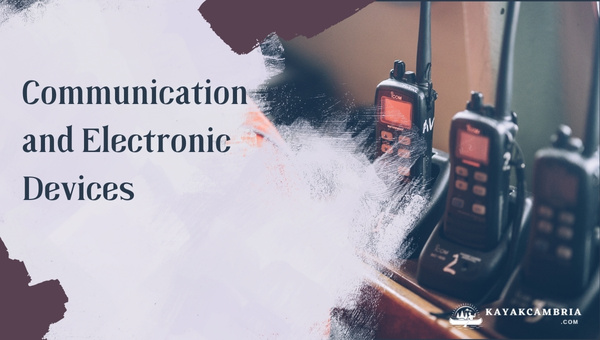
Staying connected while kayaking is essential for both safety and sharing your adventure with friends and family. Make sure to pack these communication and electronics items to ensure you always have a way to reach help or document your journey.
1. Waterproof Phone Case or VHF Radio
A waterproof phone case can protect your smartphone from potential water damage and allows you to make calls, send messages, and even check the weather forecast while on the water. Alternatively, you may opt to use a VHF (Very High Frequency) radio designed explicitly for marine communication. VHF radios provide reliable contact with other boaters, marinas, and emergency services.
2. Portable Charger or Solar Charger
Even the most powerful devices can run out of charge, especially if you’re planning on being out on the water for extended periods. A portable charger or solar charger can help you keep your electronics charged and ready for use. When selecting a charger, make sure it’s compatible with your devices and provides enough power for your needs.
3. Personal Locator Beacon (PLB) or Satellite Messenger
In case of an emergency or an unexpected situation, a Personal Locator Beacon (PLB) or satellite messenger can be a lifesaver. These devices transmit a distress signal to search and rescue services, alerting them of your location, identity, and that you need assistance. Always make sure your device is registered and functioning correctly before setting out on your kayak adventure.
Remember, a successful and enjoyable kayaking trip depends on staying connected and prepared! Communication and electronic devices are indispensable when it comes to enhancing your paddling experience while maintaining safety and care for yourself and the environment.
Environmental Awareness And Leave No Trace Principles
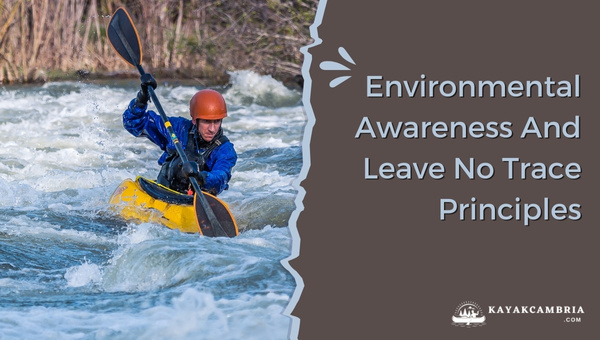
As kayakers, we have a responsibility to respect and preserve the natural environments we explore. By practicing environmental awareness and adhering to the Leave No Trace principles, we can minimize our impact on the ecosystems, wildlife, and waterways we enjoy.
Planning Ahead and Preparing
- Research the area you plan to visit to understand the environmental and wildlife sensitivities.
- Learn about local kayaking regulations, potential hazards, weather conditions, and appropriate practices for that specific location.
- Aim to kayak in small groups to reduce the environmental footprint.
Travel and Camp on Durable Surfaces
- Stick to established launch sites and landing points to avoid damaging vegetation or disrupting wildlife habitats.
- When going onshore, choose durable surfaces like sand, rock, or gravel whenever possible.
Dispose of Waste Properly
- “Pack it in, pack it out” is a guiding principle that means anything you bring with you, including trash, wrappers, or leftover food, should be taken back out with you.
- Utilize portable, self-contained toilet systems and pack out any human waste.
- Filter or treat water directly from the source to avoid introducing chemicals or contaminants to the environment.
Leave What You Find
- Preserve the natural environment by not removing, altering, or damaging features like rocks, plants, or historic artifacts.
- Avoid introducing non-native species or other contaminants by cleaning your kayak and gear, especially when transitioning between different bodies of water.
Minimize Campfire Impact
- Check local fire regulations to find out whether they are allowed or not.
- Use established fire rings or portable camp stoves instead of creating new fire sites.
Respect Wildlife
- Observe wildlife from a safe distance and avoid approaching or feeding them.
- Follow local regulations related, such as those governing interactions with marine mammals like seals or dolphins.
Be Considerate of Other Visitors
- Respect the experience of other kayakers and visitors by keeping noise levels low and giving them space.
- Yield to non-motorized crafts and follow all applicable boating rules.
By incorporating these principles into our kayaking adventures, we can all play our part in protecting the beautiful places we visit and ensuring their sustainability for future generations to enjoy. Remember, it’s crucial to leave no trace and foster a positive relationship with our natural surroundings.
Miscellaneous Items For Comfort And Convenience To Bring When Kayaking in 2024
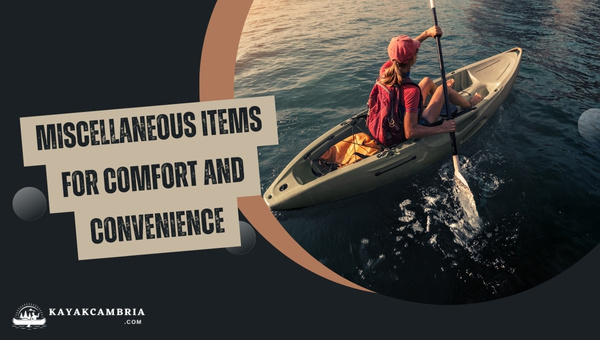
1. Camera or GoPro
Sometimes there is nothing better than capturing the beautiful moments of your kayaking adventure. A camera or GoPro is perfect for memorializing your journey. Make sure to protect your equipment with a waterproof case or bag to avoid any damage.
2. Waterproof Notebook or Journal
A waterproof notebook or journal can be a great companion for your kayaking trip, especially if you’re inclined to record your thoughts, and experiences, or even sketch the landscapes you encounter. These notebooks are specifically designed to withstand the elements, so you won’t have to worry about water damage.
3. Portable Chair or Waterproof Seat Cushion
Taking breaks during your adventure to rest or simply enjoy the view is essential. A portable chair or waterproof seat cushion can make your moments of respite more comfortable. Lightweight and compact options are available that won’t weigh down your kayak.
4. Paddling Gloves or Pogies
To protect your hands from blisters or cold temperatures, invest in some paddling gloves or pogies. Pogies are mitts that attach directly to your paddle, allowing you to maintain direct contact with the paddle shaft, unlike paddling gloves. Both options provide much-needed hand protection and ensure a comfortable kayaking experience.
Remember, personal preferences will come into play when choosing these auxiliary items. Focus on what brings convenience and comfort to your kayaking experience, and don’t overload yourself with non-essential objects.
Transporting Your Kayak And Accessories
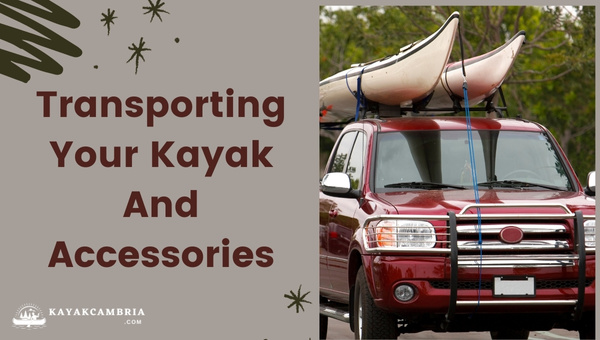
Transporting a kayak can often be a bit of a challenge, especially if you are new to the sport. Rest assured, with proper planning and equipment, getting your kayak to and from your launch point can become much easier. In this section, I’ll take you through some important aspects of transporting your kayak and accessories.
Carrying Techniques
First and foremost, it’s essential to become familiar with different kayak-carrying techniques. Depending on the size and weight of your kayak, solo-carrying or tandem-carrying methods can be useful. A common way to easily carry your kayak alone is the cockpit carry. To do this, simply stand at the side of the kayak, bend your knees and grab the cockpit rim with both hands, lift with your legs, and balance the kayak on your shoulder.
When carrying the kayak with a partner, the over-the-shoulder carry is an efficient method. Each person stands at the bow and stern of the kayak, bends their knees, and lifts the kayak on their shoulder, with one arm supporting the closest carrying handle.
Vehicle Transportation
When it comes to getting your kayak on your vehicle, roof racks or foam blocks can greatly help. If your car is equipped with a roof rack system, specific kayak carriers or saddle-style holders can be an excellent investment. These options provide secure attachment points and can protect your kayak from getting damaged during transportation.
For those without a roof rack system, foam blocks are a cost-effective and easy alternative. Foam blocks can be placed directly on the car roof under the kayak, offering protection and friction to keep the kayak secure. Regardless of the system you choose, make sure to use ratchet straps or cam buckle straps to secure your kayak and prevent any movement while driving.
Accessory Management
Once you’ve mastered the transportation of your kayak, it’s crucial to keep accessories organized and secure. A paddle leash or paddle holder attached to your kayak can ensure that your paddle doesn’t get lost or accidentally left behind. For smaller items like your PFD, helmet, or dry bags, consider investing in a dedicated gear bag or roof rack cargo box. This will help keep everything together and make loading and unloading much more manageable.
Properly transporting your kayak and accessories requires a little planning and the right equipment but, once mastered, will become second nature. This will allow you to focus on what really matters – embarking on unforgettable kayaking adventures!
Proper Documentation And Identification To Bring When Kayaking in 2024
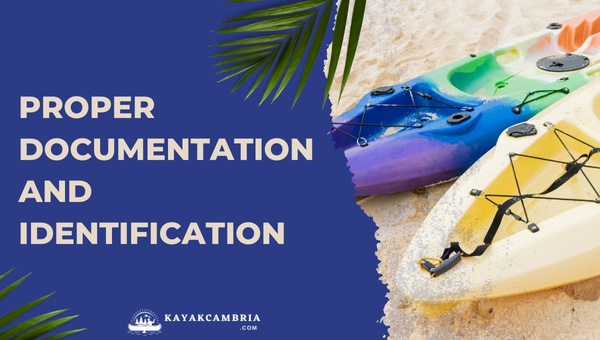
When planning any kayaking adventure, it’s crucial not only to bring the appropriate gear but also to have all the proper documentation and identification with you. These can be essential for safety, legality, and overall enjoyment of your paddling experience. Here’s a list of items to consider:
Personal Identification
It’s always essential to carry your identification on you in case of an emergency or when you need to identify yourself to park rangers, officials, or other authorities. Your driver’s license, state ID, or passport are all good options, depending on your preferred form of identification. It is recommended to store your identification in a waterproof case to keep it safe and dry.
Kayak Registration and Decals
Depending on your location and the type of water you’ll be paddling in, you might be required to have your kayak registered. Many states or national parks require registration, and you will need to display the appropriate decals on your boat. To make sure you’re adhering to the rules, visit your local state’s wildlife and fisheries website for an updated list of regulations and requirements.
Local Regulations and Permit Requirements
Some specific bodies of water may require a permit to kayak, and failure to comply with regulations could result in fines or other penalties. Researching and getting a thorough understanding of the local regulations ensures that your kayaking adventure goes smoothly. This could include obtaining any necessary permits, which might be daily, annual, or even multi-year passes, depending on your needs and the waterway’s regulations. Additionally, knowing restrictions such as no-wake zones or areas where motorized watercraft are prohibited will keep you and others around you safe.
Being prepared with the proper documentation and identification contributes to a stress-free and enjoyable kayaking trip. Keep everything safe by storing it in waterproof cases, and be aware of your kayaking destination’s regulations and requirements.
Training And Paddling Skills
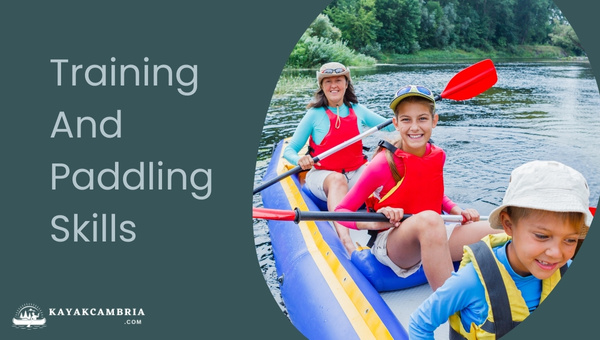
While your excitement to hit the water is understandable, it’s essential to have essential paddling skills and proper training before embarking on your kayaking journey. This ensures a more enjoyable experience and, more importantly, your safety.
Basic Strokes and Techniques
Taking the time to learn and practice the fundamental strokes and techniques will go a long way in ensuring a smoother kayaking experience. You’ll want to be familiar with the following:
- Forward Stroke: The primary stroke used to move your kayak forward.
- Reverse Stroke: Helps to stop or reverse your kayak.
- Sweep Stroke: Used to turn your kayak left or right.
- Draw Stroke: Assists in pulling your kayak sideways without turning.
Consider attending a beginner’s kayaking class or watching instructional videos online to practice these strokes.
Emergency and Self-Rescue Procedures
While we hope you won’t need them, it’s crucial to know how to handle any dire situations that may arise on the water. Be familiar with emergency and self-rescue procedures, including:
- Wet Exit: Learn how to safely exit your kayak after capsizing.
- Assisted Rescue: Understand how to help other kayakers in need.
- Self-Rescue: Be able to re-enter your kayak after capsizing without assistance.
Understanding Weather Conditions, Currents, and Tides
Before heading out, always check the latest weather forecast, as well as the tide and current conditions. These factors can greatly impact your kayaking experience. Be aware of how they might affect your trip and if they could cause extreme changes or result in potentially dangerous situations.
By investing time in enhancing your kayaking skills and understanding the environment, you are more likely to have an enjoyable time out on the water while also staying safe.
Frequently Asked Questions
1. Do I need a special type of kayak for different types of water environments?
Yes, there are various types of kayaks designed for different water environments, such as sit-on-top kayaks, touring kayaks, and whitewater kayaks. Choose the kayak best suited for the water conditions you plan to paddle in.
2. How do I choose the right-size kayak for me?
The right-size kayak depends on factors like your height, weight, and personal preference. Be sure to try out different kayak models or consult a kayak sizing chart to find the best fit.
3. Can I wear regular clothes while kayaking, or do I need specialized clothing?
Regular clothes may be suitable for calm waters and warm weather; however, quick-drying, moisture-wicking, or waterproof clothing offers added protection and comfort during long kayaking trips or in varying weather conditions.
4. How much water should I bring for a kayaking trip?
It is recommended to bring at least one liter of water per person for every four hours of kayaking. This amount may increase depending on the temperature, level of physical activity, and individual needs.
5. Is it necessary to take a kayaking course before going out on the water?
Taking a kayaking course is not necessary but highly recommended, especially for beginners. A course can teach you essential skills, safety procedures, and techniques to ensure an enjoyable and safe kayaking experience.
6. Are there any age restrictions for kayaking?
There are no specific age restrictions for kayaking, but it is essential to ensure that all participants can swim, are in good physical condition, and are wearing appropriate safety gear. Children should always be accompanied by an adult.
7. How do I store my kayak when not in use?
Store your kayak in a cool, dry place, away from direct sunlight. It’s best to store it on its side or hang it from straps to prevent deformation.
8. Is a helmet necessary for all types of kayaking?
Helmets are mainly recommended for whitewater kayaking, rocky environments, or where there’s potential for fast-moving debris. For calm waters or recreational paddling, a helmet may not be necessary but is still a good precaution.
9. How do I maintain my kayak?
Regularly inspect your kayak for damage, clean it after each use, and store it properly. Perform necessary repairs as needed, and consult a professional for extensive damage.
10. What is the best way to transport my kayak to and from the water?
Using a roof rack or foam blocks on your vehicle is the most common way to transport your kayak. For shorter distances or when not having a car, a kayak cart or carrying the kayak using the handles (with the help of a partner) are other viable options.
Conclusion
Being well-prepared is an essential aspect of enjoying a kayaking adventure to the fullest. Having the right gear, clothing, and supplies not only ensures a safer experience but also allows you to fully immerse yourself in the beauty and excitement of the great outdoors. By taking the time to thoughtfully consider and gather everything you need before embarking on your kayaking journey, you set yourself up for a smoother, more enjoyable trip.
Always keep in mind the importance of practicing safe and responsible kayaking, as it not only helps preserve the environment but also safeguards your well-being and that of your fellow paddlers. Remember, the key to a successful kayaking experience lies in your preparedness, knowledge, and respect for both nature and the sport itself. So gear up, venture out, and enjoy the amazing world of kayaking!

